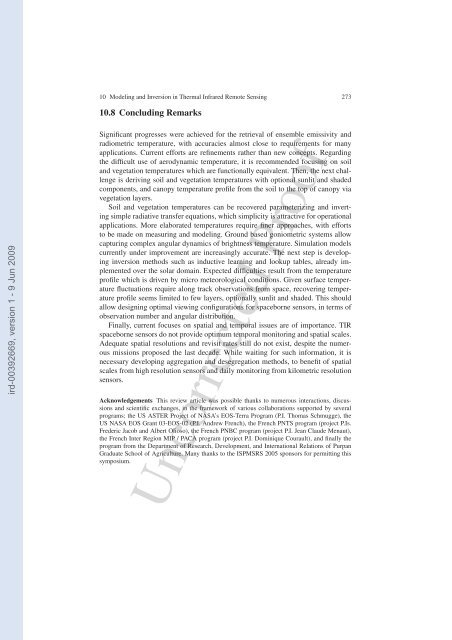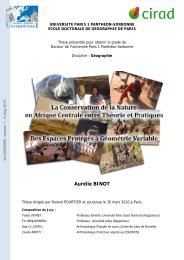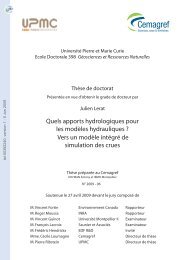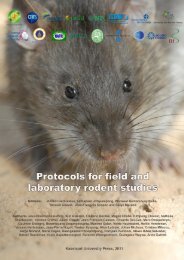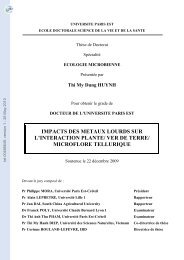Modeling and Inversion in Thermal Infrared Remote Sensing over ...
Modeling and Inversion in Thermal Infrared Remote Sensing over ...
Modeling and Inversion in Thermal Infrared Remote Sensing over ...
You also want an ePaper? Increase the reach of your titles
YUMPU automatically turns print PDFs into web optimized ePapers that Google loves.
10 <strong>Model<strong>in</strong>g</strong> <strong>and</strong> <strong>Inversion</strong> <strong>in</strong> <strong>Thermal</strong> <strong>Infrared</strong> <strong>Remote</strong> Sens<strong>in</strong>g 27310.8 Conclud<strong>in</strong>g Remarksird-00392669, version 1 - 9 Jun 2009Significant progresses were achieved for the retrieval of ensemble emissivity <strong>and</strong>radiometric temperature, with accuracies almost close to requirements for manyapplications. Current efforts are ref<strong>in</strong>ements rather than new concepts. Regard<strong>in</strong>gthe difficult use of aerodynamic temperature, it is recommended focus<strong>in</strong>g on soil<strong>and</strong> vegetation temperatures which are functionally equivalent. Then, the next challengeis deriv<strong>in</strong>g soil <strong>and</strong> vegetation temperatures with optional sunlit <strong>and</strong> shadedcomponents, <strong>and</strong> canopy temperature profile from the soil to the top of canopy viavegetation layers.Soil <strong>and</strong> vegetation temperatures can be rec<strong>over</strong>ed parameteriz<strong>in</strong>g <strong>and</strong> <strong>in</strong>vert<strong>in</strong>gsimple radiative transfer equations, which simplicity is attractive for operationalapplications. More elaborated temperatures require f<strong>in</strong>er approaches, with effortsto be made on measur<strong>in</strong>g <strong>and</strong> model<strong>in</strong>g. Ground based goniometric systems allowcaptur<strong>in</strong>g complex angular dynamics of brightness temperature. Simulation modelscurrently under improvement are <strong>in</strong>creas<strong>in</strong>gly accurate. The next step is develop<strong>in</strong>g<strong>in</strong>version methods such as <strong>in</strong>ductive learn<strong>in</strong>g <strong>and</strong> lookup tables, already implemented<strong>over</strong> the solar doma<strong>in</strong>. Expected difficulties result from the temperatureprofile which is driven by micro meteorological conditions. Given surface temperaturefluctuations require along track observations from space, rec<strong>over</strong><strong>in</strong>g temperatureprofile seems limited to few layers, optionally sunlit <strong>and</strong> shaded. This shouldallow design<strong>in</strong>g optimal view<strong>in</strong>g configurations for spaceborne sensors, <strong>in</strong> terms ofobservation number <strong>and</strong> angular distribution.F<strong>in</strong>ally, current focuses on spatial <strong>and</strong> temporal issues are of importance. TIRspaceborne sensors do not provide optimum temporal monitor<strong>in</strong>g <strong>and</strong> spatial scales.Adequate spatial resolutions <strong>and</strong> revisit rates still do not exist, despite the numerousmissions proposed the last decade. While wait<strong>in</strong>g for such <strong>in</strong>formation, it isnecessary develop<strong>in</strong>g aggregation <strong>and</strong> desegregation methods, to benefit of spatialscales from high resolution sensors <strong>and</strong> daily monitor<strong>in</strong>g from kilometric resolutionsensors.Acknowledgements This review article was possible thanks to numerous <strong>in</strong>teractions, discussions<strong>and</strong> scientific exchanges, <strong>in</strong> the framework of various collaborations supported by severalprograms: the US ASTER Project of NASA’s EOS-Terra Program (P.I. Thomas Schmugge), theUS NASA EOS Grant 03-EOS-02 (P.I. Andrew French), the French PNTS program (project P.Is.Frederic Jacob <strong>and</strong> Albert Olioso), the French PNBC program (project P.I. Jean Claude Menaut),the French Inter Region MIP / PACA program (project P.I. Dom<strong>in</strong>ique Courault), <strong>and</strong> f<strong>in</strong>ally theprogram from the Department of Research, Development, <strong>and</strong> International Relations of PurpanGraduate School of Agriculture. Many thanks to the ISPMSRS 2005 sponsors for permitt<strong>in</strong>g thissymposium.Uncorrected Proof


